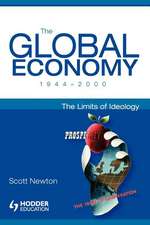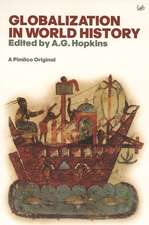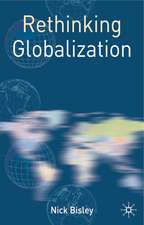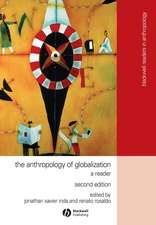Understanding Global Cultures: Metaphorical Journeys Through 34 Nations, Clusters of Nations, Continents, and Diversity
Autor Martin J. Gannon, Rajnandini K. Pillaien Limba Engleză Paperback – 27 apr 2015
This new edition presents the cultural metaphor as a method for understanding the cultural mindsets of individual nations, clusters of nations, continents, and diversity in each nation. A cultural metaphor is any activity, phenomenon, or institution that members of a given culture consider important and with which they identify emotionally and/or cognitively, such as the Japanese garden and American football. This cultural metaphoric approach identifies three to eight unique or distinctive features of each cultural metaphor and then discusses 34 national cultures in terms of these features.
Preț: 1007.55 lei
Preț vechi: 1361.55 lei
-26% Nou
192.86€ • 209.55$ • 162.10£
Carte disponibilă
Livrare economică 31 martie-14 aprilie
Livrare express 15-21 martie pentru 47.48 lei
Specificații
ISBN-10: 1483340074
Pagini: 680
Dimensiuni: 178 x 254 x 32 mm
Greutate: 1.03 kg
Ediția:Sixth Edition
Editura: SAGE Publications
Colecția Sage Publications, Inc
Locul publicării:Thousand Oaks, United States
Recenzii
“This text more thoroughly increases cultural awareness to broaden students' perspectives of what they may encounter as they travel to different parts of the world. The chapters are well written; my students are challenged by, and maintain an interest in, the level of the book. It is a book that provides a challenge for the level of students in my course.”
“This is the only textbook that I have found that actually discusses relevant information about contemporary cultures from all over the world…This is a wonderful text! I actually encourage other instructors to use it for their comparative cultures classes. It is easy to read and understand, discusses relevant information, and helps students become more aware of cultures that they may very well come in contact with. I will be using the next editions of this text, as it is the best I've found.”
“Overall I have enjoyed the text and have found it a useful resource for myself. Students who have used it as recommended reading have also found it helpful in developing a more colorful understanding of issues from the module. The structure of the book is good, with an appropriate break up of countries as it demonstrates that despite major visible differences the cultures in each category actually have important base characteristics. I am glad this text is available as it supports the broad themes of my course admirably well.”
“It is one of the most interesting textbooks in the marketplace. The authors KNOW what they are doing. I love this textbook and have been using it for years now. It is one of the only textbooks that many of my students do NOT sell back to the campus bookstore!”
“I enjoy using this book in my classes and students also seem to like it. I get positive comments on the text in student evaluations.”
“The book is a very useful resource for any one traveling to a foreign country because it provides unique in-depth insights to cultures. Thus, I encourage students to hang onto the book as a resource in dealing with customers from these countries. What I like about the current format is that the questions and the associated answers are infinite once you dig deeper into the metaphor and then start comparing/contrasting metaphors.”
“This is a fantastic book and I will continue to use it in whatever format.”
Cuprins
Preface: Understanding Cultures in Depth
Part I. Introduction
Chapter 1. Understanding Cultural Metaphors
Language Barriers
Using Cultural Metaphors
Constructing Cultural Metaphors
Using Metaphor
Reading and Using This Book
A Two-Dimensional Typology of Cultures
A Scaling Perspective
Defining Culture or Identifying Its Determinants?
When Culture Does, and Does Not, Matter
Part II. Authority-Ranking Cultures
Chapter 2. The Thai Kingdom
Loose Vertical Hierarchy
Freedom and Equality
The Thai Smile
Chapter 3. The Japanese Garden
Corporate Cultures
Garden as Metaphor
Wa and Shikata
Seishin Training
Combining Droplets or Energies
Aesthetics
Similarities and Contrasts
Chapter 4. Bedouin Jewelry and Saudi Arabia
History and Geography
The Desert Bedouins
Bold Form
Handcrafted Appearance
Traditional Design
Female Ownership
Chapter 5. Dòn Gánh: The Two Sides of Vietnam
History of Occupation
The French Defeat and Division Into Two
The Metaphor: The Dualities of Dòn Gánh
Chapter 6. Kimchi and Korea
South Korea
Kimchi
The 60th Birthday
Strangers by Day, Lovers by Night
Kimchi’s Public Role
The Irish of Asia
Part III. Scandinavian Egalitarian Cultures
Chapter 7. The Swedish Stuga
Early History
Modern Evolution
Social Democracy
The Swedish Summer Home
Love of Untrammeled Nature and Tradition
Individualism Through Self-Development
Equality
Chapter 8. The Finnish Sauna
From Survival to Political and Economic Success
Sauna: A Secular “Holy” Place of Equality
Communication: Comfort With Quietude
Chapter 9. The Danish Christmas Luncheon
Interdependent Individualism
Geographic Ambivalence
Coziness
Part IV. Other Egalitarian Cultures
Chapter 10. The German Symphony
Postwar Evolution
The Symphony Orchestra
Diversity of Musical Instruments
Positional Arrangements of the Musicians
Conductors and Leaders
Precision and Synchronicity
The Unfinished Symphony
Chapter 11. Irish Conversations
Early History
English Oppression
Identifying Links
Intersection of Gaelic and English
Prayer as Conversation
A Free-Flowing Conversation: Irish Hospitality
Places of Conversations: Irish Friends and Families
Ending a Conversation
Chapter 12. The Canadian Backpack and Flag
Historical Background
Egalitarianism and Outlook
The Canadian Mosaic
Canadians as Non-U.S. Americans
Chapter 13. Australian Outdoor Recreational Activities
Capturing the Imagination
New Realities: Beyond Stereotypes
Barbecue
Equality Matching Among the Tall Poppies
Chapter 14. French Wine
Pureness
Classification
Composition
Suitability
The Maturation Process
The Changing Portrait
Part V. Market-Pricing Cultures
Chapter 15. American Football
The Tailgate Party
Pregame and Halftime Entertainment
Strategy and War
Selection, the Training Camp, and the Playbook
Individual Specialized Achievement Within the Team Structure
Aggression, High Risks, and Unpredictable Outcomes
Huddling
The Church of Football and Celebrating Perfection
Chapter 16. The Traditional British House
The Traditional House
History, Politics, Economics: Laying the Foundations
Growing Up British: Building the House
Being British: Living in the House
Part VI. Cleft National Cultures
Chapter 17. The Malaysian Balik Kampung
Returning to Nearby Roots
Authority Ranking
Reinforcing Common Values
Chapter 18. The Israeli Kibbutzim and Moshavim
Zionism, Types of Judaism, and the Palestinians
A New Country
Continuous War
Religious Conflict
Explicit Values
Size and Behavioral Outcomes
Traumas, Worldview, and Personality
Chapter 19. The Italian Opera
North and South
The Opera Metaphor
The Overture
Pageantry and Spectacle
Voice
Externalization
Chorus and Soloists
Chapter 20. Belgian Lace
Wallonian Versus Flemish
History of Lace
A Land of Contrasts
Control
Cooperation and Harmony
Part VII. Torn National Cultures
Chapter 21. The Mexican Fiesta
Historical Background
The Mexican Fiesta
Primary Focus on People
The Emphasis on Religion
Experiencing the Present
Freedom Within the Social Order
Chapter 22. The Turkish Coffeehouse
A Unique History
Islam and Secularity
Recreation, Communication, and Community Integration
A Male Domain
A Modest Environment
Life Outside the Coffeehouse
Looking Ahead
Part VIII. The Base Culture and Its Diffusion Across Borders (Clusters of Nations): The Example of China
Chapter 23. China’s Great Wall and Cross-Cultural Paradox
The Great Wall: Long, Tortuous, and Complex History
Confucianism and Taoism
Sun Tzu, War, and the Marketplace
Chapter 24. The Chinese Family Altar: The Expatriate Chinese Outside of China
The Importance of Family
The Expatriate Chinese
Roundness
Harmony
Fluidity
Chapter 25. The Singapore Hawker Centers
Origins of the Hawker Centers
Singapore’s History
Ethnic Diversity but Unity
Efficiency
The Power of Women
Safety
Synthesizing Traditional and New Values
Part IX. India: Tradition, Modernity, and Diversity
Chapter 26. India: The Dance of Shiva
Shiva’s Dance
Indian Culture: Early History
Cyclical Hindu Philosophy
The Cycle of Life
The Family Cycle
The Cycle of Social Interaction
The Work and Recreation (Rejuvenation) Cycle
Chapter 27. India: A Kaleidoscope of Diversity
The Kaleidoscope of Religions and Cultural Celebrations
Images of Festivals and Feasts
Cell Phones, Call Centers, and Curriculum: Images of Change
The Changing Image of Cricket
Part X. An African Perspective
Chapter 28. The Nigerian Marketplace
Diversity
Social Dynamism
Balancing Tradition and Change
Chapter 29. South African Townships
An Insider’s View
An Outsider’s View
Chapter 30. The Sub-Saharan African Bush Taxi
Basic Operations
A Short History of Africa
African Time Orientation and Fatalism
Communalism and Community Sharing
Hierarchy in African Society: Seating Arrangements in the Bush Taxi
Part XI. The Struggle for Cultural Identity and the Splintering of Nations: The Case of the Russian Empire
Chapter 31. Russian Ballet
An Apt Metaphor
A Flourishing Art
Echelons of the Ballet
Drama and Realism
The Russian Soul
Chapter 32. Estonian Singing
Lyrics, or the Painful History of the Proud Nation
Vocalists, or Simple Pleasures Inspired by Nature
Performance, or Singing as a Weapon
Audience, or Estonia on the Global Stage
Chapter 33. The Polish Village Church
Historical Background
Central Place of the Catholic Church
The Partitioning and Polish Identity
Survivors
Part XII. Same Metaphor, Different Meanings
Chapter 34. The Spanish Bullfight
The Bullfight Begins
Cuadrillas
Sol y Sombra
The Pompous Entrance Parade
Audience Involvement
The Ritual of the Bullfight
Chapter 35. The Portuguese Bullfight
Pride in Traditions
Stratification Amid Unity
Artistry and Human Gore
Profitless Bravery
Part XIII. Popular Music as Cultural Metaphors
Chapter 36. The Brazilian Samba
Evolution of the Samba
Small-Step Circularity
Physical Touch
Undulation
Spontaneous Escape
Paradox of Dancers
Chapter 37. The Argentine Tango
The Tango’s Evolution
Tango Music and Composers
The Dynamics of the Dance
Tango Singers and Their Lyrics
Gender Relations
Applying What We’ve Learned
Summary
Part XIV. Overlapping Cultural Metaphors for Geographically Related Nations
Chapter 38. Cultural Metaphors for the Caribbean
A Brief History of the Caribbean Region
Cultural Metaphors for the Caribbean
Personal Experiences With Caribbean Metaphors
Developing Complementary Cultural Metaphors
Conclusions
References
Index
About the Authors
Notă biografică
Martin J. Gannon (Ph.D., Graduate School of Business, Columbia University) is Professor Emeritus of Strategy and International Management at both the Smith School of Business, University of Maryland at College Park and the College of Business Administration, California State University San Marcos. He is a three-time recipient of the Fulbright Professorship Award (West Germany, 1981-82; Thailand, 1987; and Austria, 2017-18).
His other awards include: 1) The Outstanding Educator Award, International Division, 2014, Academy of Management, the largest and best known management and teaching organization in the world; 2) the University of Maryland¿s International Landmark Award for his contributions in the global area, 2003; and 3) the Lifetime Achievement Award, Whös Who in America, 2018. See below for additional awards.
Professor Gannon has been a Senior Research Fulbright Fellow in West Germany; the John F. Kennedy Foundation/Fulbright Professor at Thammasat University, Bangkok, Thailand; and the Fulbright Professor, Johannes Kepler University, Austria. He has also been a visiting professor at the London Business School, Bocconi University (Italy), University College - Dublin, the University of Lodz (Poland), Wuhan University, Chulalongkorn University (Bangkok), and the University of Kassel and Tubingen University in Germany, and has lectured at many other universities in the world.
At the Smith School of Business he served as the Acting Associate Dean for Academic Affairs, Founding Director of the Center for Global Business, Chairperson of the Faculty of Management and Organization, Co-founder and Co-director of the Small Business Development Center, and the Founding Director of the College Park Scholars Program in Business, Society, and the Economy (an undergraduate living-learning community). He is the author of over 100 articles and papers as well as 13 books, some in multiple editions and translations (Korean, Spanish, and Italian). He recently completed a draft of his 20th book. See below.
Professor Gannon has emphasized three overlapping areas of programmatic or in-depth research: International management and behavior; business strategy; and the contingent workforce, particularly studies of temporary help employment. Much of his work in international management and behavior is described in depth in the book, Understanding Global Cultures: Metaphorical Journeys Through 31Nations, Clusters of Nations, Continents, and Diversity, 5th Edition (Sage, May, 2012, c. 2013, 639 pages; Korean translation, Myung In Publishers, 2013). Rajnandini Pillai joined him as co-author after the 3rd edition. The 6th edition was published in 2016 and includes 34 national cultures and their corresponding 34 cultural metaphors. Although the publisher wanted a 7th edition, Professor Gannon decided to pursue other writing opportunities.
In this book Gannon introduced the concept of the cultural metaphor to describe the culture of a specific nation. He defines a cultural metaphor as any institution, phenomenon or activity with which a nation¿s citizens identify emotionally and/or cognitively, for example, the Swedish stuga or unadorned summer and weekend home. He then uses these metaphors and their distinctive features as frameworks to describe in depth the values and the associated business activities in each nation. The 6th and latest edition is divided into a fourteen-part framework to classify these 34 nations and their respective cultural metaphors, clusters of nations, continents, and diversity within nations into different types, e.g., authority ranking and market pricing national cultures as separate parts.
In 2018 he was the senior author of a unique study of 28 cross-cultural experts. The goal was the analysis of the relative advantages and disadvantages of the three most popular methods of comparing and contrasting national cultures: The dimensional perspective as represented by Geert Hofstede and other cross-cultural analysts; the cultural metaphor; and the cultural paradoxical approach. See the publications below for this and other references.
He recently completed a draft of his 20th book, A Memoir of Management Insights: The Strategic Realistic Method for Life and Career Success. It combines three separate perspectives: A memoir; the management insights that the author has achieved through his many and varied activities; and a career or self-help book. As in the case of his other books, this one is unique. It is currently with an agent, who plans to submit it to 12 major publishers.
In the area of contingent employment, he has written many articles that have appeared in such journals as The Academy of Management Review, the Journal of Applied Psychology, and Industrial Relations. He is also the senior co-author of "Managing Without A Complete, Full-Time Workforce," that appeared in Flood, Gannon, Pauuwe, and Associates, Managing Without Traditional Methods: International Innovations in Human Resource Management (Addison-Wesley, 1996).
In the area of business strategy, he is the co-author of the Dynamics of Competitive Strategy (Sage, 1992), in which the authors develop a unique communication-information model of competitive interaction among firms in an industry, describe new methods for analyzing competitive moves and responses, and test hypotheses about such competitive interactions in four major industries. Mr. Gannon is also the co-author of Strategic Management Skills (Addison-Wesley, 1986), which was a pioneering effort to train MBA students and managers in strategic case analysis and written and oral presentation skills. In 2008 Ofer Meilich and Martin Gannon published an article, ¿Redefining Value: Comparative Video Case Studies of Charles Shaw Winery and Thomas Kincade,¿ in the Journal of Strategic Management Education.
As indicated above, Mr. Gannon¿s research and writing have appeared in over 100 articles and papers. Journals in which he has published include the Academy of Management Journal, The Academy of Management Review, Journal of Applied Psychology, Personnel Psychology, Industrial Relations, Monthly Labor Review, California Management Review, Business Horizons, Journal of Business Research, Journal of Business Venturing, International Journal of Management, International Journal of Intercultural Relations, Business & the Contemporary World, and the Journal of Accountancy.
Further, Professor Gannon has published several textbooks, including Management: Managing for Results (Allyn and Bacon, 1988, Spanish translation, 1996); Management: an Organizational Framework (Little, Brown and Co., 1977, and reprinted in a special edition of 10,000 copies by the Life Insurance Institute of America; second edition of this book, 1982); and Organizational Behavior (Little, Brown and Co., 1979). His organizational framework of management was incorporated into the Introduction to Management course at the Army War College for many years.
Professor Gannon has taught a range of courses over a 50-year period for managers, MBA students, EMBA students, undergraduates, and doctoral students. Currently he enjoys teaching Managing in Different Cultures; Cross-Cultural Negotiations; and Strategic Management.
Professor Gannon has served as a consultant and trainer to a large number of organizations, including Chemical Bank of New York, the U.S. General Accounting Office, U.S. Office of Personnel Management, the Upjohn Company, the American Federation of Government Employees, ARINC, Northrop-Grumman and GEICO Insurance. At GEICO he was the only external consultant on the design and presentation of the annual week-long Senior Management Training Program for ten years from which those promoted to Director and above were selected.. At Northrop-Grumman he served as the University of Maryland Academic Director of the IMPACT Training Program (International Management Program and Compliance Training), an internal certificate program required for advancement to international management positions. In 2008 he received a Career Contribution Award from GEICO. Professor Gannon has served on and chaired numerous committees in universities and professional/academic associations. He has lived and lectured in over 30 nations for various periods of time extending from one week to a year or more.
Descriere
This book demonstrates how metaphors can be used to help outsiders quickly understand what members of different cultural mindsets consider important.
















